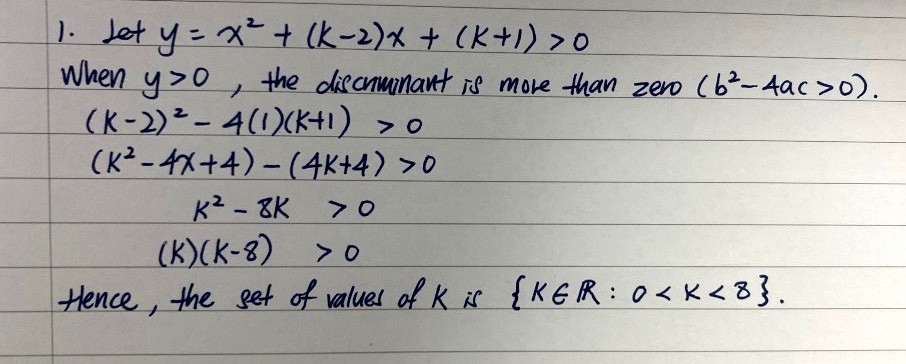QN's answer to QN's Junior College 1 H1 Maths Singapore question.
done
{{ upvoteCount }} Upvotes
clear
{{ downvoteCount * -1 }} Downvotes

Can I write my answer like that? Or do I need to add k=0 and k-8=0, k=8
Date Posted:
4 years ago
Why have you written discriminant > 0?
Let y = x² + (k - 2)x + (k + 1)
When x² + (k - 2)x + (k + 1) > 0,
y > 0
So there is no intersection of the curve and the x-axis, where y = 0
Therefore, there are no real roots for the equation x² + (k - 2)x + (k + 1) = 0
Discriminant < 0
(k - 2)² - 4(1)(k+1) < 0
k² - 4k + 4 - 4k - 4 < 0
k² - 8k < 0
k(k - 8) < 0
k² - 8k is a upward sloping parabola (u-shaped).
If we let y = k² - 8k, it has an intersection with y = 0 (the k-axis) and will cut it at 2 points, where k = 0 and k = 8
Between k = 0 and k = 8, the curve is below the k-axis and so it will be negative.
So 0 < k < 8 for k(k - 8) < 0
Or
The other way to think about it:
① If k is between 0 and 8,
Then k is positive but k - 8 is negative. So their product would be negative, which is what we want.
② If k > 8 , both k and k-8 are positive. Their product is positive which does not satisfy our inequality.
③ Likewise, if k < 0 both k and k-8 are negative. Their product is positive which does not satisfy our inequality.
④ If k = 0 or k = 8, then one of the factors is 0. Then their product is 0 , which does not satisfy our inequality.
So 0 < k < 8
Set of values of k : {1,2,3,4,5,6,7}
Or
{ k : k ∈ R, 0 < k < 8}
When x² + (k - 2)x + (k + 1) > 0,
y > 0
So there is no intersection of the curve and the x-axis, where y = 0
Therefore, there are no real roots for the equation x² + (k - 2)x + (k + 1) = 0
Discriminant < 0
(k - 2)² - 4(1)(k+1) < 0
k² - 4k + 4 - 4k - 4 < 0
k² - 8k < 0
k(k - 8) < 0
k² - 8k is a upward sloping parabola (u-shaped).
If we let y = k² - 8k, it has an intersection with y = 0 (the k-axis) and will cut it at 2 points, where k = 0 and k = 8
Between k = 0 and k = 8, the curve is below the k-axis and so it will be negative.
So 0 < k < 8 for k(k - 8) < 0
Or
The other way to think about it:
① If k is between 0 and 8,
Then k is positive but k - 8 is negative. So their product would be negative, which is what we want.
② If k > 8 , both k and k-8 are positive. Their product is positive which does not satisfy our inequality.
③ Likewise, if k < 0 both k and k-8 are negative. Their product is positive which does not satisfy our inequality.
④ If k = 0 or k = 8, then one of the factors is 0. Then their product is 0 , which does not satisfy our inequality.
So 0 < k < 8
Set of values of k : {1,2,3,4,5,6,7}
Or
{ k : k ∈ R, 0 < k < 8}
Discriminant > 0 means there are two distinct real roots or 2 real solutions to the curve y = ax² + bx + c and x-axis (where y = 0). The curve cuts/intersects the axis at 2 distinct points.
Discriminant > 0 doesn't mean that y > 0.
If y > 0 , the y-value or y-coordinate of the curve is always bigger than 0.
This means that it does not intersect the x-axis at all (where y = 0) since all its y-values are above 0.
So there are no real roots and therefore discriminant < 0 when y > 0
Discriminant > 0 doesn't mean that y > 0.
If y > 0 , the y-value or y-coordinate of the curve is always bigger than 0.
This means that it does not intersect the x-axis at all (where y = 0) since all its y-values are above 0.
So there are no real roots and therefore discriminant < 0 when y > 0


